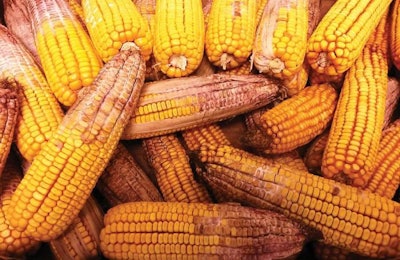
This article appears in the July/August issue of Pig International. View all of the articles in the digital edition of this magazine.
Deoxynivalenol (DON) is a major mycotoxin commonly found in mild climatic regions of North America, Europe and North Asia. In swine feed commodities worldwide, DON occurred in 79 percent of finished feed samples, 77 percent of corn samples and 92 percent of dried distillers grains with solubles (DDGS) samples analyzed. Concentrations often exceed levels known to harm animals. In 56 percent of finished feed, 68 percent of corn and 88 percent of DDGS samples, concentrations exceeded the risk threshold of 150 parts per billion (ppb).

In 56 percent of finished swine feed, 68 percent of corn and 88 percent of DDGS samples, concentrations of DON exceeded the risk threshold of 150 parts per billion (ppb).
Effects in swine
Both deoxynivalenol and nivalenol are B-trichothecenes produced by several Fusarium fungi species, mainly F. graminearum. Compared to other animals, pigs are most sensitive to trichothecenes. Their basic mode of action is the inhibition of the protein synthesis by binding to ribosomes. Ingestion of trichothecenes has been associated with alterations of the nervous and immune system, leading to vomiting and anorexia and, in consequence, to impaired performance. Trichothecenes also damage the gut barrier, granting an easier passage for pathogens, viruses and toxins across the intestinal epithelium — increasing pigs’ susceptibility to infectious diseases.
New findings
A recent study compared the impact of nivalenol and DON on pig jejunum mucosa on explants in vitro and on intestinal loops in vivo. The results showed that nivalenol had a greater impact on the mucosa at lower concentrations than DON. Both mycotoxins caused apoptosis in vivo on intestinal loops after 4 hours of exposure. Lamina propria cells — which are mainly immune cells — were even more sensitive than the epithelial enterocytes to nivalenol-triggered apoptosis. This indicates that the toxicity of nivalenol on the digestive tract is different than that of DON. Based on this, a specific hazard characterization for nivalenol is needed.
Binder effectiveness
Different counteracting strategies to protect farm animals from mycotoxins have been developed. The best known method is the use of binding agents. Bentonite, for example, is a well-known high affinity and high capacity binder that has been proven effective in counteracting aflatoxins without impacting feed quality. Absorption studies with several binder products from different markets show contrary results for DON: clay minerals at 0.2 percent inclusion level resulted in less than 25 percent adsorption rate of DON tested in vitro at pH 3.0 and pH 6.5 and organic material like yeast products bound DON at the maximum 20 percent.

The ineffectiveness of binders against DON has been well-known in the scientific community since the 1990s. As a consequence, strategies that use microbes or enzymes to detoxify mycotoxins, also referred to as biotransformation or biodetoxification, have been explored. Several strains of bacteria and yeast have been identified that transform DON into non- or less toxic metabolites, though only one has been developed for practical application in feed.
The anaerobic rumen bacterium BBSH 797 (Genus novus of family Coriobacteriacae, formerly Eubacterium) has been authorized by the European Union for its mycotoxin deactivation properties on the basis of an intensive series of tests and trials to confirm its safety and efficacy (Regulation EU No 1016/2013). Effectiveness has been demonstrated by relevant biomarkers in blood, urine or feces, as the improved performance parameters alone do not demonstrate the degradation of DON.
BBSH 797 transforms DON into non-toxic DOM-1 (deepoxy-DON), preventing harm or impaired performance in swine. In an experiment with 24 piglets, the concentration of DON in the blood serum was significantly reduced when the bacterial strain BBSH 797 was added to DON-contaminated feed.

In an experiment with 24 piglets, the concentration of DON in the blood serum was significantly reduced when the bacterial strain BBSH 797 was added to DON-contaminated feed. The piglets were fed a control diet contaminated with DON (1.8 mg/kg) or the same contaminated diet supplemented with the bacterial strain BBSH 797 at a dose of 1.7 × 108 CFU/kg feed over a 48-hour period.
Conclusion
Non- and less absorbable mycotoxins such as DON underscore the need for creative and targeted mycotoxin-counteracting strategies such as biotransformation. The European Commission was the first body to introduce standards — also well recognized outside the EU — that authorize technical mycotoxin deactivating feed additives for safety and effectiveness.

















